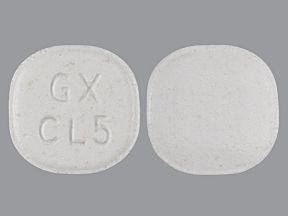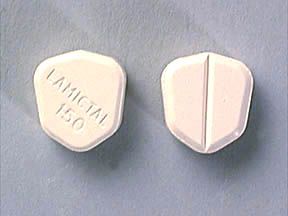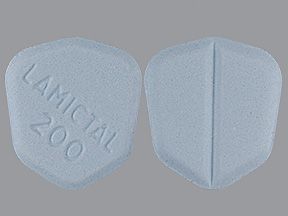Lamictal (lamotrigine) is a brand-name drug that’s prescribed for bipolar disorder and certain types of seizures. Lamictal comes in multiple forms. The dosage can vary depending on what condition the drug is used to treat.
Lamictal belongs to a drug class called antiepileptics. Lamictal is available in a generic version, lamotrigine.
Keep reading for specific information about the dosage of Lamictal, including its strengths and how to take the medication. For a comprehensive look at lamotrigine (the generic version of Lamictal), see this article.
Note: This article describes typical dosages for Lamictal provided by the drug’s manufacturer. When taking Lamictal, always follow the dosage prescribed by your doctor.
Below are the forms and strengths of Lamictal and its typical dosages.
Lamictal forms and strengths
Lamictal comes in the following forms and strengths.
- chewable tablet, which can be dissolved in liquid and is available in:
- 2 milligrams (mg)
- 5 mg
- 25 mg
- orally disintegrating tablet (ODT), which is available in:
- 25 mg
- 50 mg
- 100 mg
- 200 mg
- oral tablet, which is available in:
- 25 mg
- 100 mg
- 150 mg
- 200 mg
- extended-release (XR) oral tablet, which is available in:
- 25 mg
- 50 mg
- 100 mg
- 200 mg
- 250 mg
- 300 mg
Typical dosages
Typically, your doctor will start you on a low dosage. Then they’ll adjust it over time to reach the amount that’s right for you. Your doctor will ultimately prescribe the smallest dosage that provides the desired effect.
The following information describes dosages that are commonly used or recommended. However, be sure to take the dosage your doctor prescribes for you. Your doctor will determine the best dosage to fit your needs.
Lamictal interacts with several other drugs. Certain drugs can decrease or increase the levels of Lamictal in your blood. This can affect how the drug works or worsen its side effects. Your dosage of Lamictal depends on whether you take other drugs that interact with Lamictal and, if so, which specific drugs you take. The prescribing information includes three possible dosage regimens.
- Dosage 1: Taking a valproate drug, such as Depakote or Depakote XR (divalproex sodium), which makes your Lamictal blood levels higher
- Dosage 2: Not taking any drugs that affect Lamictal blood levels
- Dosage 3: Taking a drug that makes your Lamictal blood levels lower, including Tegretol (carbamazepine), Dilantin (phenytoin), phenobarbital, Mysoline (primidone), or Kaletra (lopinavir/ritonavir)
Dosages 1, 2, and 3 are shown in the tables below.
Dosage for bipolar disorder
Doctors may prescribe Lamictal tablets, ODTs, or chewable tablets for oral suspension to treat bipolar I disorder. This drug is typically taken with other bipolar disorder medications.
The table below shows the typical dosage schedule, including the starting dosage and maintenance dosage. Your doctor will choose a maintenance dose that suits your needs.
| Dosage 1 | Dosage 2 | Dosage 3 | |
| Weeks 1–2 | 25 mg every other day | 25 mg once per day | 50 mg once per day |
| Weeks 3–4 | 25 mg once per day | 50 mg once per day | 100 mg per day in divided doses |
| Weeks 5 | 50 mg once per day | 100 mg once per day | 200 mg per day in divided doses |
| Week 6 | 100 mg once per day | 200 mg once per day | 300 mg per day in divided doses |
| Week 7 and on | 100 mg once per day | 200 mg once per day | 400 mg per day in divided doses |
The maximum dosage for Dosage 3 is 400 mg per day in divided doses.
If you take Lamictal for bipolar I disorder, this may be a short-term treatment. If you take Lamictal for more than 16 weeks, your doctor will determine whether to continue treatment. Talk with your doctor about how long you expect to take Lamictal.
If you need to start or stop taking a different medication for bipolar disorder, talk with your doctor. Depending on your other medications, they may need to adjust your Lamictal dosage.
For more information about your specific dosage, talk with your doctor.
Dosage for epilepsy
Lamictal is prescribed to treat epilepsy in adults and certain children. Specifically, it’s prescribed to treat generalized tonic-clonic seizures, partial-onset seizures, and Lennox-Gastaut syndrome. The drug may be prescribed with other seizure drugs.
The table below summarizes dosages of Lamictal tablets, ODTs, and chewable tablets for oral suspension when prescribed with other medications in adults and children older than 12 years.
| Dosage 1 | Dosage 2 | Dosage 3 | |
| Weeks 1–2 | 25 mg every other day | 25 mg once per day | 50 mg once per day |
| Weeks 3–4 | 25 mg once per day | 50 mg once per day | 50 mg twice per day |
| Weeks 5 and on until maintenance dosage is reached | daily dose increase by 25–50 mg every 1–2 weeks | daily dose increase by 50 mg every 1–2 weeks | daily dose increase by 100 mg every 1–2 weeks |
| Maintenance dosage | 100–400 mg per day, taken in 1 or 2 divided doses | 225–375 mg per day, taken in 2 divided doses | 300–500 mg per day, taken in 2 divided doses |
Lamictal tablets, ODTs, and chewable tablets for oral suspension may be prescribed alone to treat partial-onset seizures in certain adults and children ages 16 years and older. For this use, the typical maintenance dosage is 500 mg per day, divided into two doses.
The table below summarizes dosages of Lamictal XR when prescribed for certain seizures in adults and children 13 years and older.
| Dosage 1 | Dosage 2 | Dosage 3 | |
| Weeks 1–2 | 25 mg every other day | 25 mg once per day | 50 mg once per day |
| Weeks 3–4 | 25 mg once per day | 50 mg once per day | 100 mg once per day |
| Week 5 | 50 mg once per day | 100 mg once per day | 200 mg once per day |
| Week 6 | 100 mg once per day | 150 mg once per day | 300 mg once per day |
| Week 7 | 150 mg once per day | 200 mg once per day | 400 mg once per day |
| Week 8 and on (maintenance dosage) | 200–250 mg once per day | 300–400 mg once per day | 400–600 mg once per day |
Lamictal XR tablets may be prescribed alone to treat partial-onset seizures in certain adults and children ages 13 years and older. For this use, the typical maintenance dosage is 250–300 mg taken once per day.
When prescribed alone, the drug is typically started slowly as your doctor tapers you off your current seizure drug. Your dosage of Lamictal or Lamictal XR and your taper schedule may depend on which other seizure drug you’re currently taking. Your doctor will provide details about this.
The typical maintenance dosage of Lamictal depends on several factors. These include other drugs you may be taking and how well your treatment plan is working for your epilepsy. It also depends on the form of Lamictal you take. Talk with your doctor if you have questions about your dosage.
Children’s dosage
Lamictal is prescribed to treat different types of seizures in certain children. The dosage depends on several factors, such as the child’s age and treatment plan.
Lamictal tablets, ODTs, and chewable tablets for oral suspension are prescribed with other seizure drugs to treat generalized tonic-clonic seizures, partial-onset seizures, and Lennox-Gastaut syndrome in children ages 2 years and older. Based on age, the typical dosages for children are as follows.
- For children ages 2–12, Lamictal’s dosage is based on weight.
- For children older than 12, Lamictal’s dosage is typically the same as the dosage for adults with epilepsy.
Lamictal tablets, ODTs, and chewable tablets for oral suspension may also be prescribed alone to treat partial-onset seizures in children ages 16 years and older. For these children, Lamictal’s dosage is typically the same as the dosage for adults with epilepsy.
Lamictal XR is approved for children ages 13 years and older. It may be prescribed alone or with other drugs to treat partial-onset seizures. It may also be prescribed with other drugs to treat generalized tonic-clonic seizures.
For both conditions, Lamictal XR’s dosage is typically the same as the dosage for adults with epilepsy.
For more information on the adult dosages of Lamictal, see the “Dosage for epilepsy” table above. If you have questions about your child’s dosage of this medication, talk with their doctor.
Long-term treatment
Lamictal is meant to be used as a long-term treatment. If you and your doctor determine that Lamictal is safe and effective for you, you’ll likely take it long term.
The Lamictal dosage your doctor prescribes will depend on several factors. These include:
- the type and severity of the condition you’re using Lamictal to treat
- the form of Lamictal you take
- other medications you take
- your liver and kidney function
- your age
- body weight in children
Other medical conditions you have can also affect your Lamictal dosage.
Dosage adjustments
If you have liver problems or kidney problems, talk with your doctor. They will likely prescribe you a lower dose of Lamictal.
Your doctor may also adjust your dosage during treatment, depending on how the drug affects you.
In addition, Lamictal can interact with several medications. These include certain birth control pills and antiviral medications. For more information on Lamictal’s interactions, see this article. It’s also important to tell your doctor about any medications you take before they prescribe Lamictal.
Lamictal comes in multiple forms. These include oral tablets and extended-release (XR) oral tablets, chewable tablets for oral suspension, and orally disintegrating tablets (ODTs).
Lamictal tablets and Lamictal XR should be swallowed whole. You can take them with or without food.
Lamictal ODTs can be dissolved on your tongue. You can also take them with or without food or water.
Lamictal chewable tablets can be swallowed whole, chewed, or dissolved in about 1 teaspoon of liquid. To dissolve this tablet, add it to the liquid and wait at least 1 minute. You can drink this mixture right away.
For more information on how to make an oral suspension with Lamictal, talk with your doctor or pharmacist.
If you have trouble swallowing tablets, see this article for tips on how to take this form of medication. Or you can switch to a different form of Lamictal. You can also talk with your doctor or pharmacist.
ACCESSIBLE DRUG LABELS AND CONTAINERSSome pharmacies offer labels with large print, braille, or a code you scan with a smartphone to convert text to speech. If your local pharmacy doesn’t have these options, your doctor or pharmacist might be able to recommend a pharmacy that does.
If you’re having trouble opening medication bottles, ask your pharmacist about putting Lamictal in an easy-open container. They also may recommend tools that can make it easier to open bottles.
If you miss a Lamictal dose, take it when you remember. If it’s close to the time for you next dose, skip the missed dose. Take your next dose as scheduled. Do not take a double dose.
To help make sure that you don’t miss a dose, try using a medication reminder. This can include setting an alarm or putting a note where you’ll see it, such as on your bathroom mirror or bedside table. You could also download a reminder app on your phone.
If you use more Lamictal than your doctor prescribes, you may develop harmful effects.
It’s important that you do not use more Lamictal than your doctor advises.
Symptoms of an overdose
Overdose symptoms of Lamictal can include:
- loss of voluntary muscle control
- unusual eye movements
- heart rhythm problems
- seizure
- coma
If you take more than the recommended amount of Lamictal
Call your doctor right away if you believe you’ve taken too much Lamictal. Another option is to call America’s Poison Centers at 800-222-1222 or use its online tool. If you have severe symptoms, immediately call 911 or your local emergency number, or go to the nearest emergency room.
If you need to stop taking Lamictal, talk with your doctor. They’ll create a taper schedule. This means that they’ll slowly decrease your dosage over time before you stop taking it.
A taper schedule can help reduce the risk of withdrawal symptoms, including seizures. Withdrawal symptoms are side effects that can occur if you stop taking a drug too quickly.
The taper schedule will last at least 2 weeks. Your doctor will typically decrease your dosage by half each week.
Below are answers to commonly asked questions about Lamictal.
Can Lamictal be used for weight loss, depression, or anxiety? If so, what is the dosage?
Yes, your doctor may prescribe Lamictal for weight loss, depression, or anxiety. However, these are off-label uses. With off-label use, a doctor prescribes a drug for a condition other than what it’s approved for. For this reason, there’s no recommended dosage of Lamictal for these conditions.
To learn more about Lamictal for weight loss, depression, or anxiety, talk with your doctor.
How long does it take for my dose of Lamictal to start working?
Lamictal begins working from your first dose. However, it can take 4–6 weeks to know whether this drug is effectively treating your condition.
This is because your doctor will typically start you on a low dose of Lamictal. Then, they’ll increase it over time to find the right dose for you. For this reason, it may take several weeks before you notice the drug’s full effects.
For more information, talk with your doctor or pharmacist. They can tell you how quickly Lamictal should start working for you.
The dosages in this article are typical dosages provided by the drug manufacturer. If your doctor recommends Lamictal for you, they’ll prescribe the dosage that’s right for you. Always follow the dosage that your doctor prescribes.
As with any drug, never change your dosage of Lamictal without your doctor’s recommendation. If you have questions about the dosage of Lamictal that’s best for you, talk with your doctor.
Besides learning about dosage, you may want other information about Lamictal. These additional articles might be helpful:
- More about Lamictal (lamotrigine). For information about other aspects of lamotrigine, the generic form of Lamictal, refer to this article.
- Side effects. To learn about side effects of Lamictal, see this article. You can also look at the prescribing information for Lamictal and Lamictal XR.
- Details about your condition. For details about epilepsy, see our epilepsy and seizures hub. For details about bipolar disorder, see our bipolar disorder hub.
Disclaimer: Medical News Today has made every effort to make certain that all information is factually correct, comprehensive, and up to date. However, this article should not be used as a substitute for the knowledge and expertise of a licensed healthcare professional. You should always consult your doctor or another healthcare professional before taking any medication. The drug information contained herein is subject to change and is not intended to cover all possible uses, directions, precautions, warnings, drug interactions, allergic reactions, or adverse effects. The absence of warnings or other information for a given drug does not indicate that the drug or drug combination is safe, effective, or appropriate for all patients or all specific uses.




